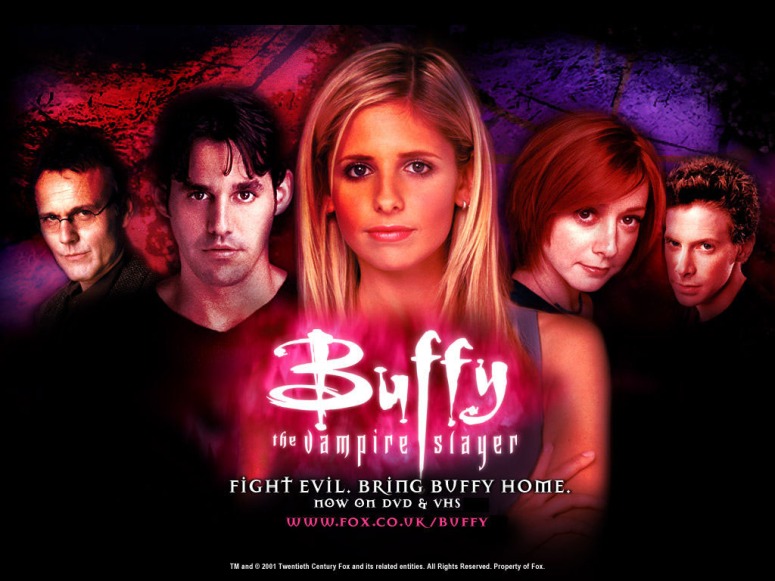
Define the term “superhero”.
I mean it. Say it out loud right now.
Okay. Now name 5 characteristics of being a superhero.
Say it out loud, one more time.
I would bet a fair wager that one of those characteristics you named is that to be a superhero, you have to have an alter ego, a marker that Buffy the Vampire Slayer passes off with flying colors. How, you may ask? Because Buffy takes on the greatest disguise of all – a disguise so perfect and so well executed that she becomes her own category of superhero, setting herself apart from the Marvel and DC’s comic legends of our day. What is this brilliant version of a super hero’s alter ego?
A stereotypical, popular, teenaged, high school girl.
Only Whedon could think up this mind-bogglingly beautiful disguise. By assuming the stereotype of “high school drama queen”, Buffy takes full advantage of all characteristics placed upon her by enveloping herself in that role, including the idea that a popular, shallow high school girl could never be a super hero. In this way, Buffy excels at concealing her identity to those not present in her inner circle. Even the audience can’t believe her true superhero powers until she is directly seen fighting the enemy.
Whedon’s focus on “what lies within”, in particular within the mind of a high schooler, is empowering. All too often grade school stereotypes are written off as their surface level appearance in an escalating self-fulfilling prophecy that may come to truly define students in their later years. Through Buffy, Whedon explains to the audience that one does not have to settle for just fitting a mold. The viewer has the power to create the mold of their dreams and nothing is beyond limits. By day, Buffy enjoys dances, classes, boys, and trendy outfits. By night, Buffy embraces her inner martial artist and hunts the monsters present in Sunnyvale, California – two contrasting characteristics that simultaneously define what the young girl stands for as a human being – two contrasting characteristics that are only contrasting because society has decided that they are so. Through taking advantage of the world’s low expectations for herself, Buffy becomes a hero in her own right. She stands as a hero to those who feel confined by their environments and the image placed upon them by their friends. And Buffy is a physical hero to an entire town who many never know of or acknowledge her accomplishments. In these ways, the genius behind Whedon’s alter-ego creation possesses the ability to empower viewers of his best known show, Buffy the Vampire Slayer.

I really like how you make your readers be interactive at the beginning of this blog post. It is engaging. Also, I feel like teen girls tend to be a common main character in many genres, but you are right. In a world of superheroes, a normal, high school girl is not what you would expect at all. I also really like your point about Buffy being a hero that many do not acknowledge. I think that makes her special when you consider how much media attention other superheroes get from the press.
LikeLike
Yes, you’re exactly right that Buffy is often left out of the superhero conversation. When Buffy was first mentioned in class, even I was guilty of thinking to myself “Buffy is a superhero?”. And even after this thought crossed my mind, it still took me thinking in a detailed manner about Buffy’s actions in order to mentally associate her directly with the superhero genre. One of the many aspects of Buffy’s character causing the disconnect could be the fact that vampires do not typically appear in superhero movies and comics. Even Buffy’s primary monster takes an extra thought to associate with the superhero genre. No wonder she becomes so disconnected in the minds of Buffy, DC, and Marvel fans alike.
LikeLike
I agree that Buffy the Vampire Slayer series is an icon of enduring popularity because it totally changed our conception of a “stereotypical, popular, teenaged, high school girl.” Usually, a lot of popular, beautiful, teenage girls are targets of “dumb blonde” jokes on screen – for example, Karen from Mean Girls. Introduction of Buffy’s dual persona was a surprising yet refreshing transition to the new portrayal of women in media and a huge challenge against prejudices that many audience used to hold.
LikeLike
I love how you bring up the example of Mean Girls. The entire basis of the Mean Girls movie is centered around the “popular high school girl” stereotype. In this way the movie both acknowledges that the stereotype exists and it reinforces the idea of the generalization made of this particular sect of young women.
LikeLike
I love the fact that by day Buffy is a stereotypical teenage girl. You did a great job pointing out how the choice Whedon made to give the slayer this kind of alter-ego can be empowering to viewers. I think that the use of this kind of seemingly shallow character as the hero of the show does a great job of making the viewer rethink the stereotypes they are so used to seeing on tv. In the commentary of the pilot episode, Joss Whedon said that he felt bad for the helpless blonde girl of most horror movies and that he wanted to give her a chance. I think this breaking of stereotypes sets up the show to be something unpredictable and is a huge part of why Buffy was so successful.
LikeLike
I couldn’t agree more about the “unpredictability” factor that stand very present within the Buffy universe. The show relies on unpredictability to engage the viewer and plot lines from every angle. Characters are unpredictable in personality, monsters are unpredictable in type, and when monsters show up is unpredictable due to the hellmouth created by the producers.
LikeLike